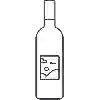
Winery Allyn et ScottCornas
In the mouth this red wine is a powerful with a nice balance between acidity and tannins.
This wine generally goes well with poultry, beef or game (deer, venison).
Taste structure of the Cornas from the Winery Allyn et Scott
Light | Bold | |
Smooth | Tannic | |
Dry | Sweet | |
Soft | Acidic |
In the mouth the Cornas of Winery Allyn et Scott in the region of Rhone Valley is a powerful with a nice balance between acidity and tannins.
Food and wine pairings with Cornas
Pairings that work perfectly with Cornas
Original food and wine pairings with Cornas
The Cornas of Winery Allyn et Scott matches generally quite well with dishes of beef, lamb or game (deer, venison) such as recipes of lomo saltado, leg of lamb in butterfly (barbecue) or rabbit with mustard in foil.
Details and technical informations about Winery Allyn et Scott's Cornas.
Discover the grape variety: Krakhouna
It is believed to have originated in Georgia, where it is grown as both a table and wine grape. In France it is not known.
Informations about the Winery Allyn et Scott
The Winery Allyn et Scott is one of of the world's greatest estates. It offers 2 wines for sale in the of Cornas to come and discover on site or to buy online.
The wine region of Cornas
The wine region of Cornas is located in the region of Rhône septentrional of Rhone Valley of France. Wineries and vineyards like the Domaine Thierry Allemand or the Domaine Thierry Allemand produce mainly wines red and white. The most planted grape varieties in the region of Cornas are Mourvèdre, Roussanne and Viognier, they are then used in wines in blends or as a single variety. On the nose of Cornas often reveals types of flavors of earthy, cream or citrus fruit and sometimes also flavors of perfume, sour cherry or lavender.
The wine region of Rhone Valley
The Rhone Valley is a key wine-producing region in Southeastern France. It follows the North-south course of the Rhône for nearly 240 km, from Lyon to the Rhône delta (Bouches-du-Rhône), near the Mediterranean coast. The Length of the valley means that Rhône wines are the product of a wide variety of soil types and mesoclimates. The viticultural areas of the region cover such a distance that there is a widely accepted division between its northern and southern parts.
The word of the wine: N-D
Negociant-distributor. In Champagne, a company that buys finished wines in bottles that are dressed under a brand name with the merchant's own labels.








